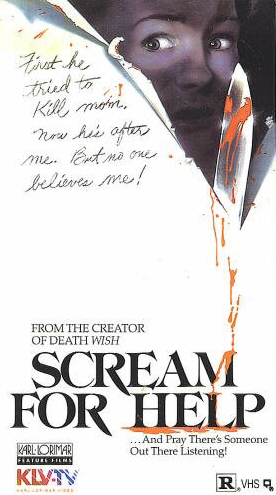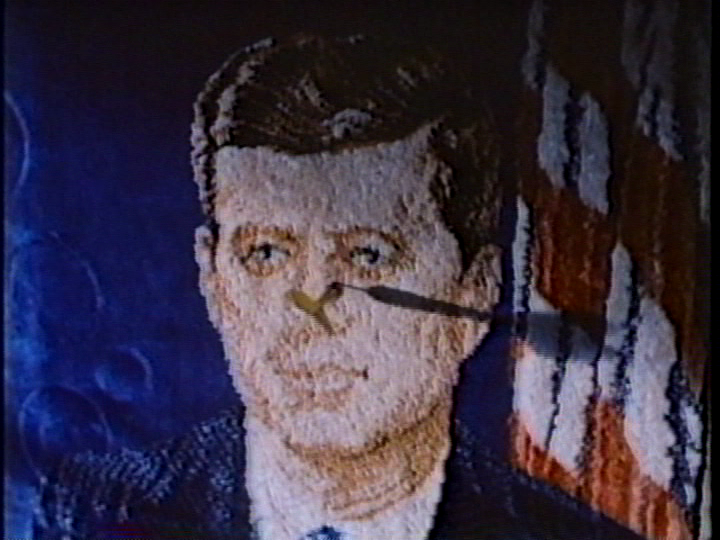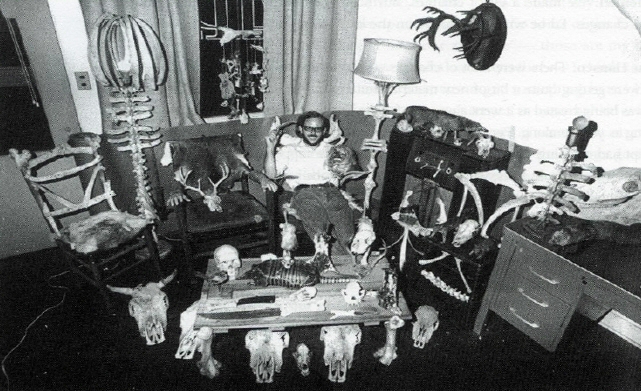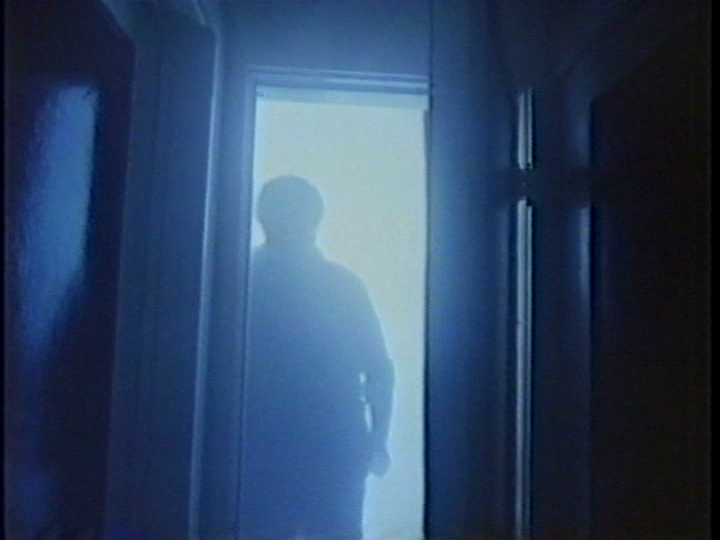2012 halloween special!
VIDEO ODDITIES,
or VHS: video house safari
~ by JOHN CRIBBS ~
By Lando's mustache, has it really been a year since the last Video Oddity? That's unacceptable... not only are these a joy to write, they're probably the easiest and shortest article-type things I put up on this site. I could blame the usual reasons, which are legit: the end of video stores, the heartbreaking breakdown of my loyal VCR of many years, how expensive it is to purchase a vintage video when you can even find it.
But there's really no good excuse except that I guess I'm always trying to branch out into more challenging topics, which takes up more of my time even when most of them don't come out half as good as some of these Oddity reports. Well, I wasn't going to miss the annual Halloween oddity, so here it is, in all its M-loaded glory, the morbid tale of Mongrel.
MONGREL
robert a. burns, 1982
Over the rocks, in the crevice of which the candle burned, there was thrust out an evil yellow face, a terrible animal face, all seamed and scored with vile passions. Foul with mire, with a bristling beard, and hung with matted hair, it might well have belonged to one of those old savages who dwelt in the burrows on the hillsides. The light beneath him was reflected in his small, cunning eyes which peered fiercely to right and left through the darkness, like a crafty and savage animal who has heard the steps of the hunters.
- Arthur Conan Doyle, The Hound of the Baskervilles
Well, if I am a dog, the party is on:
I gotta get my groove,
'Cause my mind done gone.
- Baha Men, Who Let the Dogs Out?
PART ONE: too hot to stop
This marks the second time in Video Oddity history that I've cheated slightly. I came up with a small set of informal rules - a code, if you will - back at the beginning, and the first rule of Fight Cl - er, Video Oddity Selections was that I wouldn't have any prior knowledge of the movie whatsoever. I broke that rule when I chose to write about The Dead Pit: although I was initially captivated by the wonderful video cover with its glowing zombie eyes, I'm not sure I would have actually rented it had it not been for my previous experience of the work of director Brett Leonard. The name of the Lawnmower Man auteur on the back of the video box should have made that one an instant disqualification, but I decided to pick it anyway (and I'm glad, it's one of the better movies I've watched for this series.) I had the same experience when I first beheld the cover of Mongrel, which has printed beneath its goofy/creepy image of an attacking dog "written & directed by Robert A. Burns."
That name might not mean much to most people, but it certainly does to me: Burns just happens to be the unsung genius behind The Texas Chain Saw Massacre. A central Texan graphic artist hired by Hooper as the film's art/production designer based on his reputation as a man able to "make something out of nothing," Burns took a $3,000 design budget and used it to create the gruesome lair of the film's murderous clan, renting a Victorian house from friends and filling it with furniture made from scouring cow skeletons and other animal bones that constitute the family's repulsive feng shui. He built the giant, infernal barbecue pit at the Cook's gas station, supplied grandma's idling corpse (his own touch which was incorporated into the script) and made the Leatherface masks. On top of that, Burns also took charge of stunts and special effects: he even poured his own sugar glass to create the window Sally jumps through, since the production couldn't afford to buy one. Needless to say, all this went a huge way towards making Texas Chain Saw the uniquely odd and disquieting experience that it is. Just think of Leatherface hammering Kirk and slamming the metal door shut: that effect wouldn't have been possible without the impenetrably heavy door, the sick red of the walls behind it and the various animal skulls decorating Leatherface's inner sanctum. Following the success of TCM, Burns went on to dress such memorable sets as the mutant cannibals' underground cave in Wes Craven's The Hills Have Eyes, the eerily sterile Colony in Joe Dante's The Howling and mausoleum-like morgue of Stuart Gordon's Re-Animator. His work constructing the endless labyrinths of Slausen's Last Oasis, occupied by hundreds of sinister waxwork mannequins, made him the star of David Schmoeller's Tourist Trap. He also worked on Rudy Ray Moore's Disco Godfather and Larry Cohen's Full Moon High (and, somewhat less prestigiously, contributed to previous Video Oddity subject Microwave Massacre.) Despite being in demand, Burns continued to spend most of his time in Seguin, Texas, remaining heavily involved in the state's thriving film community while Tobe Hooper ran off to Hollywood to do Stephen King adaptations and get mistreated on Steven Spielberg sets.
Still, I was intrigued to learn that Robert Burns had written and directed a film of his own in 1982, apparently - based on the cover of the Paragon video box - a killer dog movie, a subgenre that was already pretty well established within the horror realm. In the previous decade, James Brolin had run afoul of six dobermans in Trapped (1973), all breeds were induced into mass attacks in Burt Brinckerhoff's Dogs (1976) and The Pack (1977) were desperate enough to try and eat the greasy ass of Joe Don Baker (and of course there were the more complicated four-legged bank robbers of 1972's The Doberman Gang.) A guilty pleasure of mine is Albert Band's Dracula's Dog, aka Zoltan...Hound of Dracula (1978), in which a vampiric doberman starts turning pets at a campground into his furry little minions, produced the same year was Curtis Harrington's TV movie Devil Dog: The Hound of Hell, where a pooch is possessed by a demon and is thereby inclined to try and kill everyone. 1982 was a particularly prolific year for evil dogs, undoubtedly due to the publication of Stephen King's Cujo the year before (the movie was churned out a year later.) There were the Dogs of Hell, bred and trained by the U.S. military to kill humans. Alice Cooper got chased by a horribly burned werewolf-dog in Claudio Fragasso's Monster Dog aka The Bite. Obviously, the best of all of them was Samuel Fuller's White Dog, completed in 1982 but never given a theatrical run in the States. While eluding that movie's second act prestige, Mongrel was just as obscure: the dog depicted on the its cover promised to be another in a long line of killer canines, the box's taglines even hinting at something supernatural. "Tormented visions of a beast." "Does it really stalk the halls at night?" "Vivid nightmares of a frightened man show people dying, bodies ripped apart. In his own mind he knows that something or some one is to blame for the horrors within the house." So who is this beast who may or may not be stalking the halls, ripping apart dream people and possibly to blame for the horrors within the house? What does it have to do with the frame of a big, burly, Leatherface-built man in the doorway during some kind of nightmare sequence during the title credits? Is he the owner? Is he satan? Is it a demon dog? The alternative Paragon sleeve art even suggests the mongrel is a three-headed hellbeast like Cerberus: maybe it's the hound of hell itself. A three-headed monster loose in Texas? Who will survive and what will be left of them???
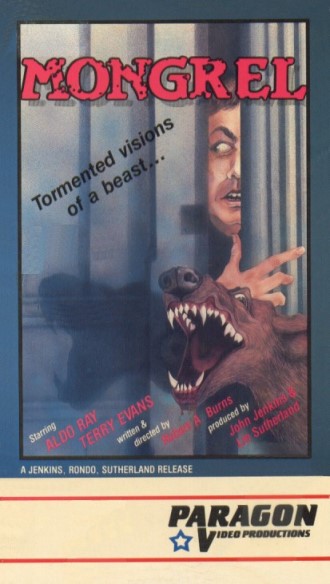
PART TWO: bad blood
Like Texas Chain Saw, Mongrel focuses on a bunch of weirdos living under the same roof: while this bunch is every bit as crass and dysfunctional as the Sawyers, they would technically be considered "normal." On the surface, the most outrageous characteristic of any of the tenants of the boarding house where all Mongrel's action takes place is bluish-green hair on Turquoise, the matron of the household who apparently spends all day gardening, although she occasionally cooks and participates in the odd game of Lee Harvey Oswald darts (JFK was killed in Dallas after all, it's probably a grim point of pride to certain Texans.) She's apparently shacked up with Woody, the house's smartass, prank-loving, apparently unemployed bully who thinks collecting rent checks for the landlord gives him some sort of authoritative position in the household. Under his thumb is the aptly dubbed Toad, a squirrely suck-up who sadly seems to think a guy named Woody is the epitome of cool. New to the apartment is Ken, also appropriately named since he's a stiff, dapper doll of a dude with no discernible qualities beyond his humorless demeanor. For some reason, this bland blondie appeals to both Jerry, a frightened little mousy book editor who becomes his instant buddy, and Sharon, the homely girl from upstairs who takes a shine to him. This development doesn't sit well with Ike, a lanky, bespectacled Weird Al-lookin' military enthusiast living in the room across from Ken who hasn't gotten over a recent break-up with the notably plain Sharon. So Ike hates Ken, who hates Woody, who hates Jerry, who really hates Woody, who hates Ike...one thing Mongrel does really well is establish how intolerable it is living with other people in one big house ("Did you see what that scumbag's done now?" one asks another, the reply being "Which scumbag is that?") While it may seem that petty resentments and hurtful-yet-harmless household pranks would never lead to somebody being killed, the basic, unmonitored Big Brother dynamics and their eventual consequences are more or less believable considering the level of mutual loathing. In fact the only resident who doesn't seem to hate or be hated is Leon, some guy who keeps insisting everyone work together to solve problems that arise in the house but never lifts a finger to actually put his words into action. As a result, only one of the eight occupants end up finishing the movie.
Then there's the ninth resident, Ike's dog Brute. Chained up in the front yard, perpetually barking at anything that moves, Brute's become such a fixture of life at the house that when he starts going off, the people inside acknowledge: "There's the doorbell." Nobody at the house likes Brute very much except his owner, who somewhat sarcastically insists he's "gentle as a kitten!" and "realllllllllllll friendly!" Particularly unnerved by the mutt's presence is Jerry, who it's established was maimed by a dog when he was young and is still effected by the memory to the point that he freezes up and breaks out in a cold sweat at the sound of Brute barking - he's convinced that "some day he's gonna break the chain and hurt somebody bad." No sooner has Ken moved in, the others are predicting that an irritated Woody will eventually kill the noisy Brute. Both predictions turn out to be true one day when Jerry playfully provokes the dog, only to get a faceful of teeth when Brute breaks from his bounds and attacks him. I thought it was weird that Jerry would be goofing around with Brute at all, since he's so petrified of the dog, but Burns does something really cool: he shows Jerry at the window, frozen in fear, literally watching himself being torn apart by this monster, a clever way to show a trauma victim experiencing something horrific happening to him as an out-of-body observer, several feet away from the actual attack. That is, I thought it was really cool until I realized that it was actually Toad being attacked: the tiny dark-haired actors playing Jerry and Toad look a lot alike, and I mistook one for the other (although I guess it still works: since Toad looks like him, Jerry remembering his own mauling could only seem more profound in his memory.) Anyway - to clarify - Toad is the one who teases the dog and is set upon, prompting Woody to dispatch the beast with a bullet. A Killing of Satan-style narrative trick? Is Brute, like Lando, really out of the game before he's able to tear out any throats? (Toad survives the assault with mild scratches.) Or is this the inciting incident to something darker and more supernatural down the line?
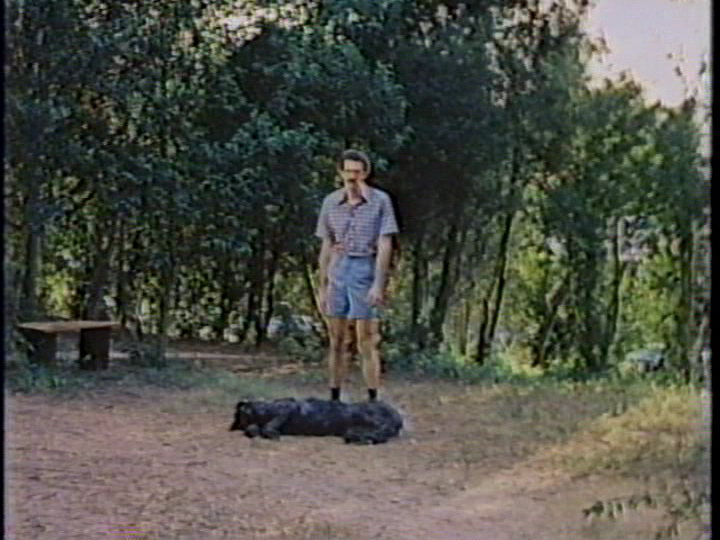
PART THREE: burned by love
While Turquoise nurses Toad back to health by serving him cornmeal mush with peanut milk, which turns out blue - according to Turquoise, blue corn is better for you than yellow corn* - tensions rise in the household. Naturally, Ike is pretty pissed about Woody shooting his dog, but Woody is just content to have found the perfect excuse to get rid of the mangy cur. Since Ken's such a dud, Jerry's such a weakling, Sharon's so unappealing, Toad's such a suck-up and Leon's practically non-existent, Woody - full name Woodward Burkowski - quickly emerges as the most interesting character, a coverall-wearing, boisterous hillbilly who rigs up hubcaps to fall out of people's closet as some sort of abstract joke. He's played by former defense contractor Mitch Pileggi, in his film debut (I had always assumed it was Three O'Clock High), which makes him the second actor after Robert Englund to work with this Texas-based group of filmmakers in an early role as a sleazy redneck only to go on to play the monster in a Wes Craven movie (Craven never made a killer dog movie, although The People Under the Stairs featured a memorably vicious rottweiler named Prince.) Pileggi's performance, about as far away from quiet, secretive, mild-mannered FBI Assistant Director Walter Skinner as you can get, reminds me of David Cross' vitriol-spewing redneck character on Mr. Show (he's just a couple arrests and a lilting melody away from Ronnie Dobbs, honestly.) He does a nice job going from obnoxiously prodding to suddenly threatening, as when he warns Toad re: Turquoise: "Keep your hands off her smoothies, y'hear?" At one point, he shows off by crushing a tomato.
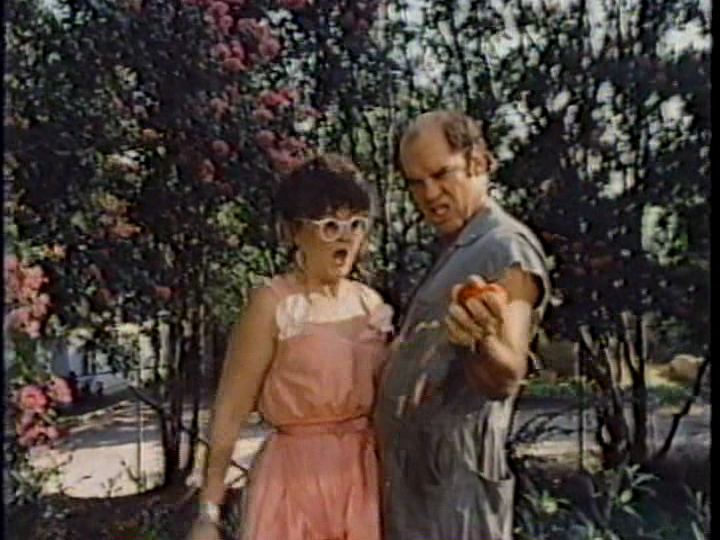
Shockingly, despite his burning hatred for him, Ike offers Woody an alliance to play a "prank" on Ken. This is strange, since all Ken's done is make moves on Ike's ex-girlfriend. Woody not only shot his dog, he immediately bought himself a new puppy, a serious "fuck you" since their lease apparently includes a "one dog only" clause. But apparently Ike's willing to literally let sleeping dogs lie as they team up to take a little starch out of Ken's stuffed shirt. Woody's inspired plan is set in motion: they get Sharon out of the house on false pretenses, then when Ken arrives inform him that she's waiting upstairs in his bedroom. When a grinning, promptly-disrobed Ken sneaks into the darkened room, he's horrified to discover the body of Ike's dead dog under the sheets, dressed in an alluring negligee. Ike and Woody lock the door and turn up the war sound effects record they know drives Ken crazy, but everything goes haywire when Ken seriously freaks out, spills water on the floor and tries to switch on the lamp, only to electrocute himself. Ken's death is Burns' finest moment: it all plays out very realistically, there's good use of darkness in Ken's room and the editing is tight, moving back and forth between Ken's writhing body and the guys outside who quickly realize something's gone horribly awry when the hall lights begin to flicker before petering out entirely. This is the sort of scene that could be incredibly cheesy, but for all the movie's shortcomings this part proves that Burns is at least a competent director of action and environment. Possibly the best moment of the movie comes when Sharon returns from her phony errand only to stop in her tracks as all the lights in the dark house suddenly flare up at once and the loud war sound effects blare from the windows, power having just been restored in the aftermath of the horrible accident.
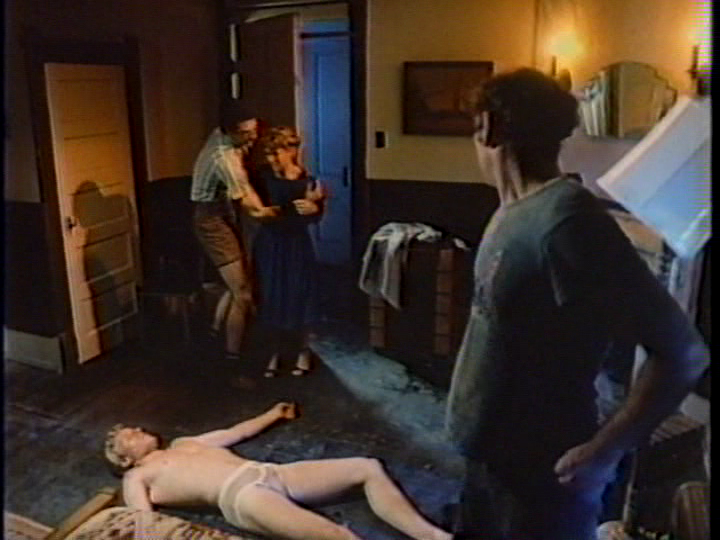
PART FOUR: wild dogs
So in the tradition of Shallow Grave and Happiness of the Katakuris, the group's now got a body in a room they have to worry about, but in this case they just call the cops after removing any evidence of the dead dog gag and plead innocence. Sharon is reasonably shocked, but rather than cause trouble simply decides to move out (an odd reaction, considering how sinister the whole thing must seem to her.) For his part, Jerry is inconsolable over the death of his boring friend and verbally condemns the prank perpetrators for what he perceives as being somehow intentional on their part. That these idiots are more malicious than homicidal, and disturbingly indifferent to the death of someone who lived with them, doesn't make Jerry feel better. Neither does seeing the decaying dead dog left on the lawn, still wearing the nightie like some cross-dressing Sirius Remembered - this kind of thing is just not good for Jerry's mental state. Like the similarly distressed and anti-social Karl from My Brother Has Bad Dreams, Jerry begins having some seriously bad dreams, thus identifying him as the "frightened man" with nightly visions of "bodies ripped apart" as promised by the video box. And indeed, as advertised, he begins to hear something stalking the halls, knocking against the walls and emitting an inhuman growl. The "monster growl" doesn't sound like a dog: it actually sounds more like one gross protracted beer burp. But I like it: it's very Texas Chain Saw, using a sound completely different from what it's supposed to be to throw the audience off - just think of the pig squeal that's initially connected to Leatherface his first appearance. It's unmistakably a growl, but from what sort of throat it could possibly emanate is anyone's guess. Jerry, whose last name is apparently "Shy" (it sounds like it anyway when a character asks "Mr. Shy, was it?"), is beyond terrified but feels he has "No place else to go!" (amusing, since this movie came out the same year as An Officer and a Gentleman - I'm sure Burns would have also included a Joe Cocker/Jennifer Warnes power ballad duet had his budget allowed...or at least ZZ Top's "Tush.")
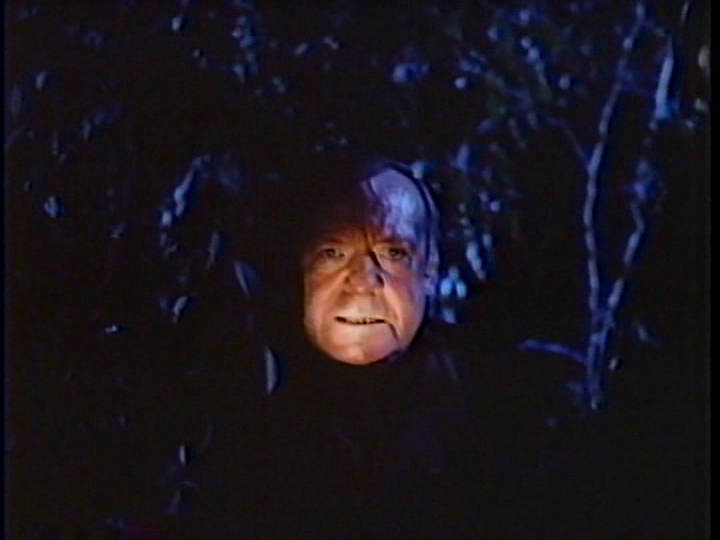
The mysterious belching beast makes its first move by mauling Woody's new dog into little puppy pieces - Woody is convinced Ike did it out of revenge, but that theory is thrown out the window when Ike turns up torn to shreds himself in the bushes, discovered by Turquoise as she waters the grass (for some reason in this scene, she's humming "The First Noel" - the only parallel to the plot is that Ike is found "laying in a field" like those lazy shepherds from the carol, but if that's the only connection she may as well have been whistling "Steal My Sunshine" or something a little more contemporary** and in-season.) A couple cops show up and start asking questions, and it's at this late stage the movie introduces Aldo Ray as homeowner Mr. Bouchard, the nosy, distrusting, crusty old landlord in the tradition of Norman Fell from The Graduate. Hey, remember that classic scene from Anthony Mann's Men at War where Ray slaps the shit out of a shell-shocked Victor Morrow? Great, great scene. Ray doesn't have anything nearly as great to do in this one, but he brings to the table some of that standard late period Aldo Ray creepiness and low tolerance for bullshit, showing up outside the house in the middle of the night (ostensibly spying on his tenants) and effortlessly emasculating Woody in front of everyone else by demanding to know what the hell's going on at this property. It's funny because up to now, the other characters have made a point of explaining that Mr. Bouchard isn't around very much, now all of a sudden he's all over the place like a leather-faced fly on the wall. He provides the already tense household a tangible menace, since whatever it was that attacked Ike, knocked off his Herschel Savage specs and then managed to somehow drag the corpse away has managed to remain elusively off-camera.
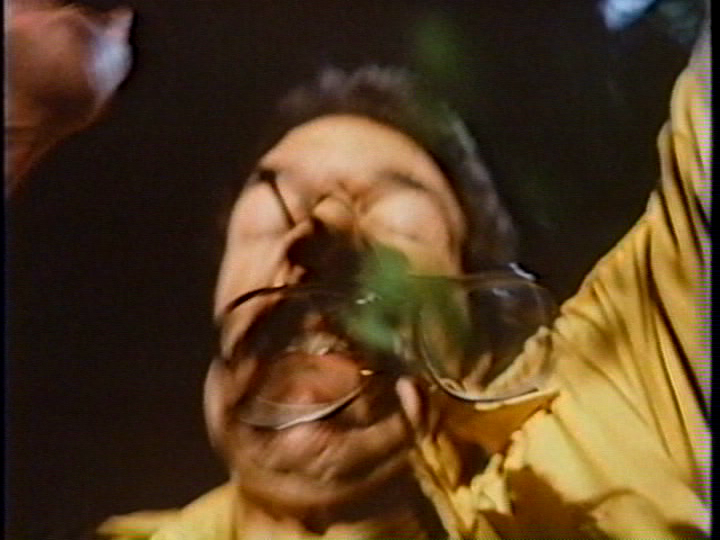
PART FIVE: end of the line
So what's the doggone twist here? Are the animal noises going to turn out to be another one of Woody's inexhaustible pranks? Has the wronged spirit of Ken somehow merged with the hideously decomposed body of Brute for a little of the ol' man-possessed-dog-zombie vengeance? Is the creepy, prowling Aldo Ray really a were-dog? Or could it be that the bereaved and distressed Jerry has taken on the persona of the vicious critters he fears so much and started attacking his hated co-inhabitants, reliving the attacks through violent, deceptively-disturbed dreams the night after? I'll throw you a bone: it's that one. That's right, the ghost dog was framed! It's been Jerry the Mongrel all along, going all growly and mangling his housemates while has dreaming of being a dog, much like another nerdy Jerry. This explains the evasieness of the video box's banners - "tormented visions," "vivid nightmares," "in his own mind," how could it have been more obvious? - and why nothing clearly stated that this was indeed a killer dog movie. It's its own subgenre, the guy-who-thinks-he's-a-killer-dog movie. Of course, that depends on whether or not Jerry has been aware of his acts the whole time, and that's debatable: in short order, he dispatches Woody, useless Leon and Turquoise but promptly straightens up and prepares to lure his next victim. Jerry only really comes alive in this final reel, as kind of a Jeffrey Combs-type were-nerd, where as earlier he was an uninteresting loser you hoped to see gobbled up by the thing in the hallway. I guess that's acting for you, and nice work by Burns for keeping the big reveal a secret with the throw-off fantasies and misleadingly establishing Jerry as the victim (the character also shares a name with the famous cartoon mouse, so that may have been an intentional attempt to keep the audience off Jerry's, ah, scent.)
It's a weird twist, one that most reminds me of Val Lewton & Jacques Tourneur's The Leopard Man, which opens with a fatal attack by an actual leopard, but from that point on the killing is clearly being done by someone outside the Panthera pardus species. The title and previews of the 1943 film suggested the sinister art of some half-man half-leopard killer (The Wolf Man had just come out 2 years earlier), and there's some subtle intrigue at the beginning: has the waiter who was clawed by the cat as it beat a hasty retreat from the night club been given the mark of the beast? But even the characters in that film start questioning whether the victims were ravaged by a leopard or a sick lunatic fairly early on, pretty much right after his first murder - it's more a confirmation than a twist later on when they find the jungle cat dead right in the middle of the killing spree. It's been a flesh-and-blood man all along, one cognizant of his actions but unable to resist the compulsion to brutally assault women in the manner of the mighty cat who killed the little girl.
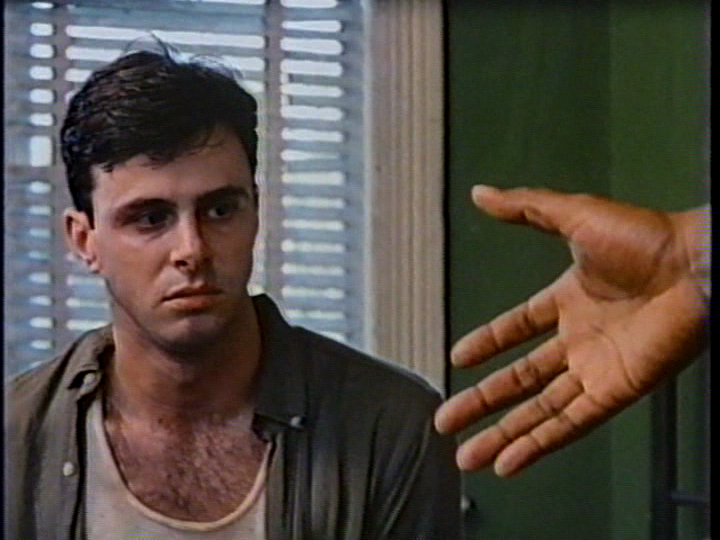
The "leopard" man's victims are strictly female, but Jerry tends to go after men (and one woman associated with the male group, Woody's girlfriend Turquoise.) That suggests something sexual behind his poochy pastime, especially since his scenes with the strapping, prosaic Ken are brimming over with homoeroticism. If you really wanted to page Dr. Richmond to the set of Mongrel, there'd be a case to made for ol' Jerry lashing out (literally) against his own sexual urges, the result of some childhood trauma that may or may not have been dog-related. For me, the central image of the movie is Jerry glaring distrustingly at the cop's hand - he looks like he's ready to pounce (this is prior to Jerry being revealed as the mighty mongrel-man.) Maybe I've seen White Dog too many times, but this inherent mistrust of a strange black man suggests how Jerry's just reading the surfaces and reacting to his base instincts. That a dog would theoretically do the same, and could be conditioned to attack whatever it perceived as a threat, is where Jerry discovers a common bond with his canine mental oppressor.
So anyway, everyone's dead. Everyone except... TOAD?! The Final Guy is Toad?? Sure enough, here comes this tiny sycophant, returning to the house in the wake of Jerry's threescore kill. Jerry tricks him into the basement and attacks - after an intense fight to the death...Toad throws Jerry against a protruding nail in the wall, and kills him! Toad wins! Despite his complete unlikability, this moron who set everything in motion by teasing Brute and getting the hound shot has somehow triumphed over the - no no, wait. Wait...I confused the two actors again. Turns out it was Toad who bought it, and Jerry's still alive. I mistook which one got killed, and was further confused that Toad's end is more like a classic bad guy's defeat (impaled on a spike or fence or jagged rock) than the throat-ripping we all expected. Unbelievable. Incidentally, do you know what happens to a Toad when it's impaled on a rusty nail? Same thing that happens to everything else!
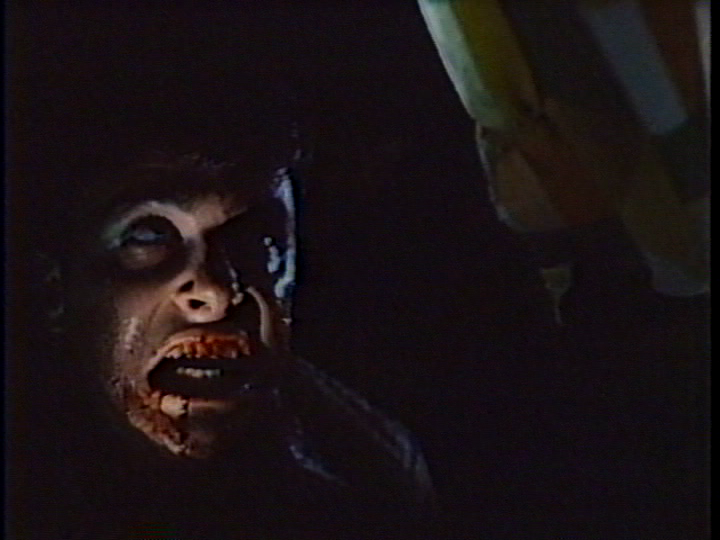
Then of course there's Sharon - I'd forgotten about her, a) because she moved out of the house and seemingly out of the movie and b) she's exceptionally bland and forgettable. Unaware of his tendency towards the animalistic, Sharon tries to convince Jerry to come with her to the new multi-roommate house she's just moved into, apparently about to inadvertently start the cycle all over again. Jerry however decides she's coming on to him and makes a sweaty, imprudent play which she wastes no time shutting down, despite her exceedingly average looks. This sends Jerry into a frenzy and out comes dog boy, chasing a shrieking Susan (I mean "Sharon" - god, she really is just unspeakably generic) down to the basement, as she Laurie Strodes her way past dead former roommates so that the entire picture is painted for her. Ultimately, Aldo Ray saves the day! Having cornered Susan/Sharon in the corner of the cellar, Jerry lunges for her and is shot in the back at the same time, revealing Mr. Bouchard in the background holding the smoking rifle, a nice touch by Burns. The movie ends abruptly two shots later, leaving the surviving couple alone in the unadorned basement.
It's noticeably unadorned, too - the biggest disappointment of the film is the lack of Robert A. Burns' signature crazy production design. There's no credited designer, so I assume Burns did his own dressing, but although the movie - like Texas Chain Saw - takes place largely in one big house, there isn't much effort to make it interesting. There's some faux-grittiness (oh - the screen door has a tear in it...how squalid these folks' lives!) and one sliding door that kind of looks like the giant steel trap from TCM, but for the most part it seems like Burns' big ace was to put lots of neon signs in the background.
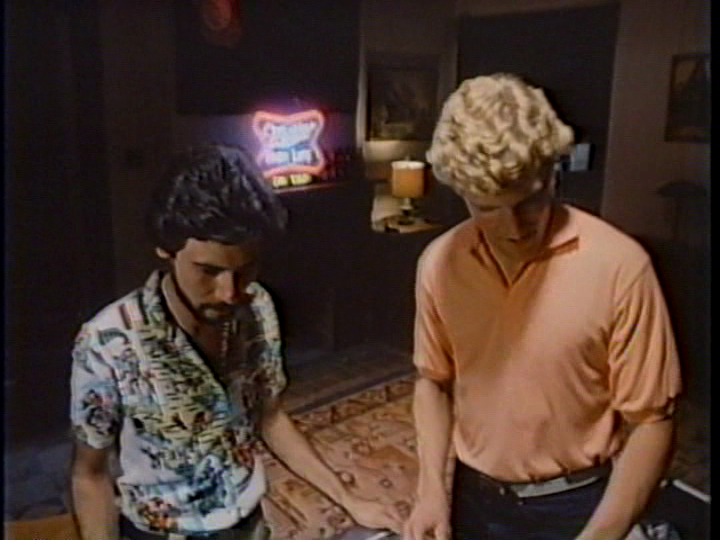
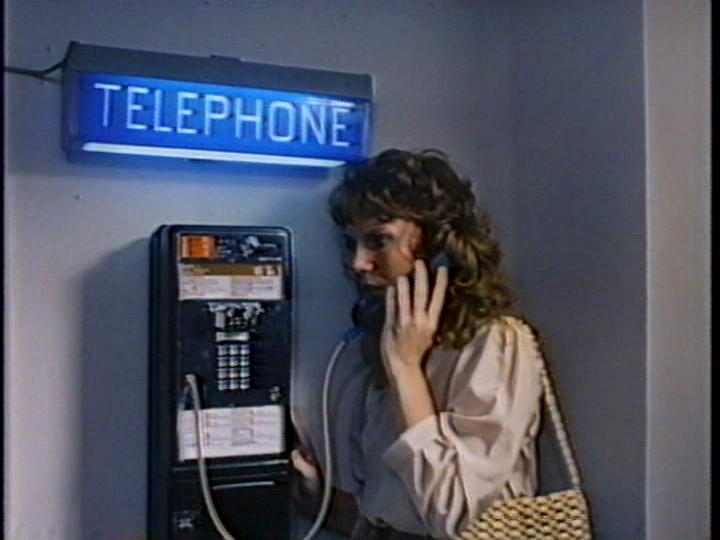
The most memorable addition to the mostly dull interior design of the house (white walls, really?) is a custom-built Deep Throat pinball machine in the rec room that gets plenty of its own close-ups. Then there's the Kennedy dartboard, I guess that's ok. Burns does make up for this lack of interesting props and sets with expertly-handled scenes, and there's no real indication that talent was completely absent from the production...but he obviously could have used a Daniel Pearl, or a Sallye Richardson, or a Wayne Bell, or a Tobe Hooper.
And who the was that bulky figure in the door frame of the opening credits? His wide girth doesn't fit any of the lanky characters from the movie. Was it Jerry's abusive fat father? Was it the malevolent spirit of Bad House Manners that set the group against one another? Who knows... maybe it was Snuff Maximus.
(I couldn't find a good place to bring this up, but have you seen George Kuchar's The Mongreloid? It's so goddamn beautiful.)
* I got excited for a minute, because I thought there was a reference to "blue corn" in the Broken Bells song 'Mongrel Heart' - it would be funny if that song were inspired by the movie. But I checked, it's actually "black corn" they refer to in the song.
** Ok, Len fans - I know that single didn't drop until 1999, I'm just being a smartass as usual. (What, no Len fans out there? C'mon, the title of their 2005 album was a Gogol reference, I'm sure they must have something going for them apart from their one-hit wonder status.) [One of their members is named "the Drunkness Monster" which I always thought was pretty good. - funderburg.]
APPENDIX,
or what i learned later
I can't recall ever reading about a real life murderer who thought he was a dog and chewed up his victims: dogs more often end up the victims of serial killers like David Berkowitz and Jeffrey Dahmer. The closest I can figure was the southwestern Indiana serial killer Leslie "Mad Dog" Irvin, so nicknamed after being led into court on what resembled a chain dog leash. He didn't maul his victims, though.
The alternative Paragon vhs cover art by Les Edwards (who designed the UK quad poster for Graveyard Shift, which I love) was also used for the album Wild Dogs by blue collar metal band The Rods, formed by Ronnie James Dio's cousin after leaving Elf shortly before that group became Rainbow. The Rods, who appeared on Iron Maiden's infamous Number of the Beast tour, released Wild Dogs in 1982, the same year as Mongrel (I took it upon myself to reference the track list in the chapter headings on this article.) The VHS cover added a moon, futher suggesting a transformation of a human into a dog. Two years later the Rods created the awesomely-named Let Them Eat Metal, with a cover that would drive Bobbi Flekman up the wall and corresponding song titles including "She's So Tight" and "She's Such a Bitch."
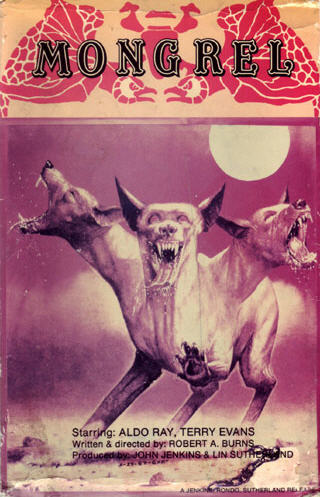
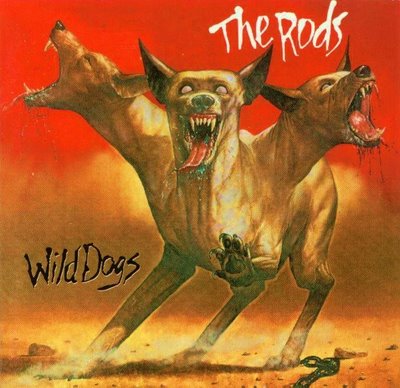
It's the famously sad tale of Aldo Ray that he was forced to accept any acting assignment after be diagnosed with throat cancer to cover his costly health insurance, which ironically caused him to lose all his benefits after he was dropped by SAG for appearing in non-union movies. I'm sure he hated every minute of shooting Mongrel, but it had to have been better than getting the lead character of Tarantino's worst movie named after you.
Terry Evans who, in his first movie role, played Jerry and got billing beside Aldo Ray on the VHS cover, went on to do a little TV work and appeared in Breast Men, but is most notable for writing the title song for Walter Hill's Crossroads and Michelle Manning's Blue City. Apparently, his soul and blues music arose from his background growing up appreciating fellow black musicians such as...wait, what? Oh - imdb fucked up. That's a different Terry Evans, a blues guitarist who worked with acts like Ry Cooder in the 80's. His film credits are listed as the achievements of Mongrel's Terry Evans (who did TV stuff and Breast Men but that's it. Fix that, imdb.)
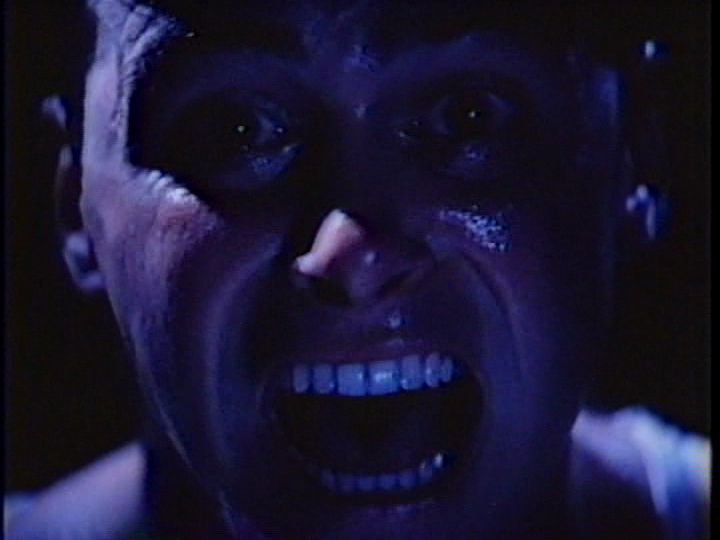
This was the first in a series of one movie for Andy Tienann (Ken), Daniel Medina (Leon) and Jonathan M. Ingraffia (Ike). Rachel Winfree (Torquiose) has gone on to appear in films such as Donnie Darko, Old School and Ron Howard's How the Grinch Saved Christmas.
A bunch of the (small) crew were attached to the Texas Chain Saw gang. Director of photography Richard Kooris would go on to shoot TCM 2. The music is the only composer credit on imdb for Ed Guinn, who played the Cattle Truck Driver in Texas Chain Saw. Mongrel was co-produced by Lin Sutherland, writer and producer of The Whole Shootin' Match, which Lou Perryman, Wayne Bell and a bunch of other 'Saw notables were involved with.
A lot of the same crew worked on 1985's Future-Kill, another TCM-related title starring Edwin "Hitchhiker" Neal and Marilyn "Sally" Burns about a toxic poison protester who gets turns into a mutant, possibly in the future. The Deep Throat pinball machine made a brief appearance in the opening of the movie in the background of a fraternity party. According to the commentary by Neal and director Ronald "Not the Battlestar Galactica Guy" Moore, the machine WAS custom made by Burns, who received credit as location manager on Future/Kill.
Of the crew Don Kirk, the film loader, appears to have had the most notable post-Mongrel career, working on two of the most prestigious Texas productions of modern cinema by serving as clapper loader on Blood Simple and doing some kind of uncredited camerawork on Dazed and Confused.
Burns would go on to work on a killer dog movie the very next year by serving as art director for Peter Wittman's shot-on-video Play Dead, in which Yvonne De Carlo uses magic powers to get a vicious rotweiller to murder her relatives. He directed one last film, the documentary Still Chainsaw After All These Years, released in 2004. Unfortunately that was the same year Burns committed suicide, having been diagnosed with inoperable cancer. He left behind a farewell message to family and friends on his website, as well as an unproduced screenplay about Rondo Hatton he was still talking about doing as late as this interview.
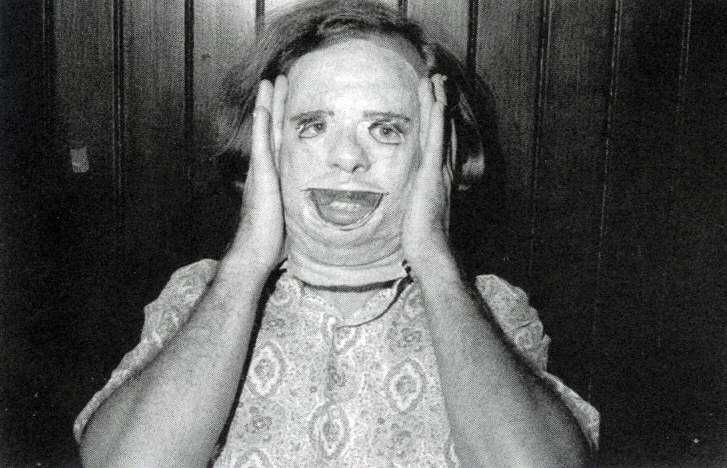
Damn - the weird suicide curse of the Video Oddities continues.
So how did Burns' fellow TCM crew fare after leaving Leatherface to swing the saw on the side of the road? Who survived the shoot and what was left of them? Kim Henkel wrote Eaten Alive with Hooper, then 1983's Last Night at the Alamo before returning to the well by writing and directing Texas Chainsaw Massacre: The Next Generation, starring Matthew McConaughey as Counselor Troi; he wrote the script for this year's horror film Boneboys. Wayne Bell worked sound on Boneboys, as well as Future-Kill, TCM 2 and a handful of Richard Linklater movies as recent as 2012's Bernie. D.P. Daniel Pearl became Larry Cohen's cameraman for a while, lit a bunch of music videos, then sold his soul by agreeing to shoot the unforgivable TCM remake. Sallye Richardson - 'saw's outspoken editor and A.D. - apparently never worked on a movie again, while her co-editor J. Larry Carroll ended up co-writing Tourist Trap and a bunch of 80's cartoon episodes. And production manager Ron Bozman has gone on to fame as producer and first assistant director on several Jonathan Demme productions.
Blue corn does indeed have several nutritional advantages over standard yellow or white corn. It contains 20% more protein and has a lower glycemic index than white corn, and when used to make tortillas produces a sweeter, nuttier taste than yellow or white corn, and is a more complete protein source.
Finally, can anybody explain these lyrics to me from Bob Seger's song Mongrel: "With a fortrel polyester ink well hord, Hot assed, Inkwell Lord"?
~ OCTOBER 27, 2012 ~
COMING SOON...
SCREAM FOR HELP!
